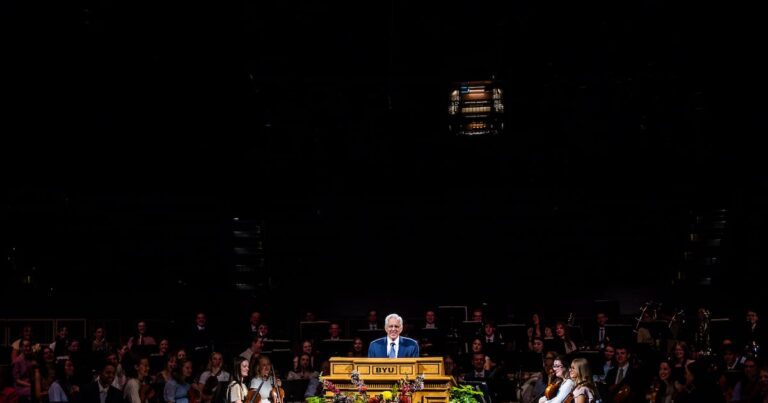April 17, 2025, 9:44am MDT
Provo, Utah – Brigham Young University’s latest addition may not be the biggest of its kind, but it is “one of the best,” commenting to Elder D. Todd Christofferson about the quorum of the 12 apostles.
A small number of universities devote the entire building to music research, while BYU’s new 171,000-square-foot music building (state-of-the-art practice and performance space) was said to be the existence of Vastovast because of its vast presence in society.
Speaking from the pulpit on the central stage of the 1,000-seat concert hall in the new building, students from BYU are adjacent to each other. Elder Christofferson said that the power of music and “lifting up the tired spirit with all his heart, talking about peace to the soul, talking about peace to the soul, giving courage, giving courage, giving courage, giving courage, and thanking our children. You.”
Elder Christofferson asked the Lord to accept the structure as a gift and a valuable offering. “We allow you to praise you and your beloved son in music and songs, and in our lives. May we strengthen our faith, strengthen our testimony and strengthen our conversion in this musical building, in the school of music, and in the lives of its teachers and students,” he prayed.
Elder Christofferson was his wife, Sister Cathy Christofferson. Elder Clark G. Gilbert, Director General of Education, at the age of 70. BYU President C. Shane Reese and his wife, Sister Wendy Reese; Academic Vice President Justin Collings held the meeting.
In addition to comments by Elder Christofferson and President Reese, the program for dedication included musical numbers by the Chorale Chamber Ensemble and numbers by the By Philharmonic Orchestra.
With the echoing of the BYU Philharmonic Orchestra’s final notes reduced, Sister Christofferson first provided a standing ovation for the direction of Camille Saint-Sands’ Symphony No. 3, “The Organ Symphony.”
Elder Christofferson called the musical performance “magnificent” during his dedicated service and spoke about how he attended an orchestra performance with his sister Christofferson several years ago, featuring guest violinist master Itzhak Perlman.
The orchestra said, “It was obviously tirelessly working in preparation and deserved to be at the same stage. Their talent made me want to jump up and sing.
President Reese said the beautiful performance was “a symbol of the amazing things that happen at music schools.”
He called the new building “splendid” and recalls a conversation with Diane Reich when it was set up as the director of a music school. She asked, “What can the music school do uniquely do to contribute to BYU’s mission?”
In response, President Reese said he wanted to set a special focus on music that directs students, faculty, staff and audiences towards Jesus Christ. “And I’m pleased that the music school has responded,” President Reese said in dedication. “Every time I hear students, choirs, orchestras, bands, ensembles, I get very inspired. During practice and performance, their music points to us to Jesus Christ. Their collective work is centered around Christ.”
About the new music building
BYU’s music school, like other visual, performing arts and communication programs, was previously housed at the Harris Fine Arts Centre, which was demolished in early 2023.
Construction of the music began in June 2020, and the music department began using the facility in 2023.
The building’s cutting edge features and upgrades were all designed with 435 BYU music students in mind.

For example, concert halls are designed with what is called “vineyard style.” There, seats surround the stage and rise into a line like a sloped terrace of a vineyard.
You can customize the sound by operating the hall ceiling and fringe wooden panels.
“There are no seats in the hall that are either acoustically or visually bad,” the article on the music website states.
Performance spaces, teacher offices and practice areas included small gaps between the walls that helped separate sounds from the rest of the building. result? The pianists can practice the scale in the room next to the trumpeter’s rehearsal Wagner, and they don’t bother each other, an article in “Y Magazine” about the new facility explained.
“We’re loud,” says Jeremy N. Grimshaw, professor of music and associate dean of the College of Art and Communications. “(The musician) is a bad neighbor.”
In addition to the concert hall, practice room and office, the building also features a recording studio, a recital hall, a choir hall, a spacious ensemble room and a theatre stage.

Professor Don Cook, a BYU organ professor, said in a BYU news release that the new building’s “Crown Jewel” is a pipe organ found in the concert hall.
It is the third largest organ in Utah with 4,613 pipes and 81 sets of pipes, and the only organ with two consoles.
For two and a half years, Létourneau Organs, an organ builder in Quebec, Canada, designed and built the organ for 25 full-time artisans, installing pipes ranging from 32 feet to pencil lengths.
The organ can create “the kind of sound you feel in your belly,” said Andrew Forest, president and artistic director of Letonneau Organs, in a news release.
Joseph P. Beck II, BYU Facility Project Manager above the building, told “Y Magazine” that it was fun to wander the building when students first opened and heard music playing from all the spaces. “It was a miracle for me to see the buildings start working quickly for our students.”
